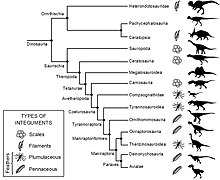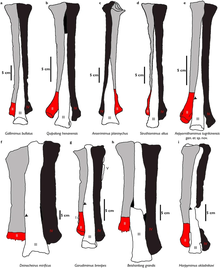User:A Cynical Idealist/sandbox5
| A Cynical Idealist/sandbox5 Temporal range: Early Cretaceous
~126 Ma - Late | |
|---|---|

| |
| The holotype on display in the Geological Museum of China | |
| Scientific classification | |
| Domain: | Eukaryota |
| Kingdom: | Animalia |
| Phylum: | Chordata |
| Clade: | Dinosauria |
| Clade: | Saurischia |
| Clade: | Theropoda |
| Clade: | †Ornithomimosauria |
| Clade: | †Macrocheiriformes |
| Genus: | †Shenzhousaurus Ji et al., 2003 |
| Type species | |
| †Shenzhousaurus orientalis Ji et al., 2003
| |
Shenzhousaurus (meaning "lizard from the Divine Land", after an ancient name for China) is an extinct genus of ornithomimosaurian theropod dinosaur that was discovered in the Early Cretaceous Yixian Formation of Liaoning, China. The genus contains a single species, the type species S. orientalis, named after the Latin word for "eastern". There is only one specimen of the genus, which preserves most of the body, the head, the tail, one hand, and parts of the legs.[1]
Discovery[edit]

Shenzhousaurus was discovered by Chinese farmers at a locality called Sihetun, which is near Beipiao in western Liaoning Province in China. It was the first ornithomimosaur to be recovered from the Yixian Formation. When the specimen was excavated, it was accidentally broken, and the block containing the skeleton was split in half. This destroyed several of the bones, including those of the head, which are crushed.[1]
During preparation, the two blocks were rejoined and then the matrix surrounding the specimen was removed. The skeleton is relatively complete, however most of the forelimbs are missing along with the pectoral girdle and the very end of the tail. The parts of the specimen which are preserved are fully articulated, and the skeleton is positioned in the normal theropod death pose.[1]
Shenzhousaurus was formally described in 2003 in the American Museum Novitates (the in-house publication for the American Museum of Natural History) by Qiang Ji, Mark Norell, Peter Makovicky, Ke-Qin Gao, Shu'An Ji, Chongxi Yuan. It was notable among ornithomimosaurs at the time because of the presence of teeth in the jaws, when most ornithomimosaurs known from the time were edentulous.[1]
The holotype, and only specimen, of Shenzhousaurus was given the designation NGMC 97-4-002 and is on display in the Geological Museum of China in Beijing.[1]
Description[edit]

Shenzhousaurus was a relatively small ornithomimosaur
- Size of holotype elements in description:
- Princeton Field Guide size estimate:
- Facts and Figures size estimate:
- Apomorphies:
Skull[edit]
Postcranial skeleton[edit]
Ichnofossils[edit]
Classification[edit]
- Analyses: Deinocheirus,[2] Tyrannomimus,[3] Qiupalong,[4] Kinnareemimus,[5] Cau 2024,[6] Brusatte 2014[7]
Paleobiology[edit]
Integument[edit]

Pneumaticity[edit]

- Pneumaticity[10]
Locomotion[edit]

- Footprints[11]
Paleoecology[edit]
Diet[edit]
Predation[edit]
Paleoenvironment[edit]
Contemporary fauna[edit]

See also[edit]
- Feathered dinosaurs
- Jehol biota
- Paleobiota of the Yixian Formation
- Timeline of ornithomimosaur research
Source gathering[edit]
- Hexing[20]
Gallery[edit]
References[edit]
- ^ a b c d e Ji, Qiang; Norell, Mark A.; Makovicky, Peter J.; Gao, KE-QIN; Ji, SHU'AN; Yuan, Chongxi (2003). "An Early Ostrich Dinosaur and Implications for Ornithomimosaur Phylogeny". American Museum Novitates (3420): 1. doi:10.1206/0003-0082(2003)420<0001:AEODAI>2.0.CO;2. ISSN 0003-0082.
- ^ Lee, Y.N.; Barsbold, R.; Currie, P.J.; Kobayashi, Y.; Lee, H.J.; Godefroit, P.; Escuillié, F.O.; Chinzorig, T. (2014). "Resolving the long-standing enigmas of a giant ornithomimosaur Deinocheirus mirificus". Nature. 515 (7526): 257–260. Bibcode:2014Natur.515..257L. doi:10.1038/nature13874. PMID 25337880. S2CID 2986017.
- ^ Hattori, S.; Shibata, M.; Kawabe, S.; Imai, T.; Nishi, H.; Azuma, Y. (2023). "New theropod dinosaur from the Lower Cretaceous of Japan provides critical implications for the early evolution of ornithomimosaurs". Scientific Reports. 13. 13842. doi:10.1038/s41598-023-40804-3. PMC 10484975.
- ^ Li Xu; Yoshitsugu Kobayashi; Junchang Lü; Yuong-Nam Lee; Yongqing Liu; Kohei Tanaka; Xingliao Zhang; Songhai Jia; Jiming Zhang (2011). "A new ornithomimid dinosaur with North American affinities from the Late Cretaceous Qiupa Formation in Henan Province of China". Cretaceous Research. 32 (2): 213–222. doi:10.1016/j.cretres.2010.12.004.
- ^ Samathi, Adun (2024). "Phylogenetic position of Kinnareemimus khonkaenensis (Dinosauria: Theropoda: Ornithomimosauria) from the Lower Cretaceous of Thailand". Zootaxa. 5448: 67–84. doi:10.11646/zootaxa.5448.1.4.
- ^ Cau A. (2024). A Unified Framework for Predatory Dinosaur Macroevolution. Bollettino della Società Paleontologica Italiana, 63(1): 1-19.
- ^ Brusatte, Stephen L.; Lloyd, Graeme T.; Wang, Steve C.; Norell, Mark A. (2014). "Gradual Assembly of Avian Body Plan Culminated in Rapid Rates of Evolution across the Dinosaur-Bird Transition" (PDF). Current Biology. 24 (20): 2386–2392. doi:10.1016/j.cub.2014.08.034. PMID 25264248. S2CID 8879023.
- ^ Van Der Reest, Aaron J.; Wolfe, Alexander P.; Currie, Philip J. (2016). "A densely feathered ornithomimid (Dinosauria: Theropoda) from the Upper Cretaceous Dinosaur Park Formation, Alberta, Canada". Cretaceous Research. 58: 108–117. doi:10.1016/j.cretres.2015.10.004.
- ^ Darla K. Zelenitsky; François Therrien; Gregory M. Erickson; Christopher L. DeBuhr; Yoshitsugu Kobayashi; David A. Eberth; Frank Hadfield (2012). "Feathered Non-Avian Dinosaurs from North America Provide Insight into Wing Origins". Science. 338 (6106): 510–514. Bibcode:2012Sci...338..510Z. doi:10.1126/science.1225376. PMID 23112330. S2CID 2057698.
- ^ Watanabe, Akinobu; Eugenia Leone Gold, Maria; Brusatte, Stephen L.; Benson, Roger B. J.; Choiniere, Jonah; Davidson, Amy; Norell, Mark A. (2015). "Vertebral Pneumaticity in the Ornithomimosaur Archaeornithomimus (Dinosauria: Theropoda) Revealed by Computed Tomography Imaging and Reappraisal of Axial Pneumaticity in Ornithomimosauria". PLOS ONE. 10 (12): e0145168. Bibcode:2015PLoSO..1045168W. doi:10.1371/journal.pone.0145168. PMC 4684312. PMID 26682888.
- ^ Xing, Li-da; Harris, Jerald D.; Feng, Xiang-yang; Zhang, Zhi-jun (2009). "Theropod (Dinosauria: Saurischia) tracks from Lower Cretaceous Yixian Formation at Sihetun Village, Liaoning Province, China and possible track makers". Geological Bulletin of China. 28 (6): 705–712.
- ^ Cerda, Ignacio A. (2008). "Gastroliths in an Ornithopod Dinosaur". Acta Palaeontologica Polonica. 53 (2): 351–355. doi:10.4202/app.2008.0213.
- ^ Zanno, Lindsay E.; Makovicky, Peter J. (2011). "Herbivorous ecomorphology and specialization patterns in theropod dinosaur evolution". Proceedings of the National Academy of Sciences. 108 (1): 232–237. Bibcode:2011PNAS..108..232Z. doi:10.1073/pnas.1011924108. PMC 3017133. PMID 21173263.
- ^ Zhong, Yuting; Huyskens, Magdalena H; Yin, Qing-Zhu; Wang, Yaqiong; Ma, Qiang; Xu, Yi-Gang (2021-04-12). "High-precision geochronological constraints on the duration of 'Dinosaur Pompeii' and the Yixian Formation". National Science Review. 8 (6): nwab063. doi:10.1093/nsr/nwab063. ISSN 2095-5138. PMC 8288181. PMID 34691675.
- ^ Xu, Xing; Wang, Xiao-Lin; Wu, Xiao-Chun (1999). "A dromaeosaurid dinosaur with a filamentous integument from the Yixian Formation of China". Nature. 401 (6750): 262–266. Bibcode:1999Natur.401..262X. doi:10.1038/45769.
- ^ L. Xing, P. R. Bell, P. J. Currie, M. Shibata, K. Tseng and Z. Dong. 2012. A sauropod rib with an embedded theropod tooth: direct evidence for feeding behaviour in the Jehol Group, China. Lethaia 45:500-506
- ^ Matsukawa, Masaki; Shibata, Kenichiro; Sato, Kenta; Xing, Xu; Lockley, Martin G. (2014). "The Early Cretaceous terrestrial ecosystems of the Jehol Biota based on food-web and energy-flow models". Biological Journal of the Linnean Society. 113 (3): 836–853. doi:10.1111/bij.12368.
- ^ Zhou, Zhonghe; Wang, Yuan (2010). "Vertebrate diversity of the Jehol Biota as compared with other lagerstätten". Science China Earth Sciences. 53 (12): 1894–1907. Bibcode:2010ScChD..53.1894Z. doi:10.1007/s11430-010-4094-9.
- ^ Han, Gang; Mallon, Jordan C.; Lussier, Aaron J.; Wu, Xiao-Chun; Mitchell, Robert; Li, Ling-Ji (2023). "An extraordinary fossil captures the struggle for existence during the Mesozoic". Scientific Reports. 13 (1): 11221. Bibcode:2023NatSR..1311221H. doi:10.1038/s41598-023-37545-8. PMC 10354204. PMID 37464026.
- ^ Jin Liyong, Chen Jun and Pascal Godefroit (2012). "A New Basal Ornithomimosaur (Dinosauria: Theropoda) from the Early Cretaceous Yixian Formation, Northeast China". In Godefroit, P. (ed.). Bernissart Dinosaurs and Early Cretaceous Terrestrial Ecosystems. Indiana University Press. pp. 467–487. Bibcode:2012bdec.book.....G.











